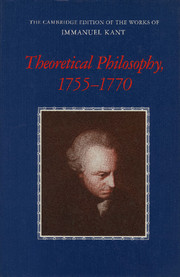Book contents
- Frontmatter
- Contents
- General editors' preface
- Preface
- Guide to abbreviations
- General introduction
- Introductions to the translations
- Résumés of the works
- A NEW ELUCIDATION OF THE FIRST PRINCIPLES OF METAPHYSICAL COGNITION (1755)
- THE EMPLOYMENT IN NATURAL PHILOSOPHY OF METAPHYSICS COMBINED WITH GEOMETRY, OF WHICH SAMPLE I CONTAINS THE PHYSICAL MONADOLOGY (1756)
- AN ATTEMPT AT SOME REFLECTIONS ON OPTIMISM (1759)
- THE FALSE SUBTLETY OF THE FOUR SYLLOGISTIC FIGURES (1762)
- THE ONLY POSSIBLE ARGUMENT IN SUPPORT OF A DEMONSTRATION OF THE EXISTENCE OF GOD (1763)
- Preface
- Section 1 In which is furnished the argument in support of a demonstration of the existence of God
- Section 2 Concerning the extensive usefulness peculiar to this mode of proof in particular
- Section 3 In which it is shown that there is no other possible argument in support of a demonstration of the existence of God save that which has been adduced
- ATTEMPT TO INTRODUCE THE CONCEPT OF NEGATIVE MAGNITUDES INTO PHILOSOPHY (1763)
- INQUIRY CONCERNING THE DISTINCTNESS OF THE PRINCIPLES OF NATURAL THEOLOGY AND MORALITY (1764)
- M. IMMANUEL KANT'S ANNOUNCEMENT OF THE PROGRAMME OF HIS LECTURES FOR THE WINTER SEMESTER 1765 — 1766 (1765)
- DREAMS OF A SPIRIT-SEER ELUCIDATED BY DREAMS OF METAPHYSICS (1766)
- CONCERNING THE ULTIMATE GROUND OF THE DIFFERENTIATION OF DIRECTIONS IN SPACE (1768)
- ON THE FORM AND PRINCIPLES OF THE SENSIBLE AND THE INTELLIGIBLE WORLD [INAUGURAL DISSERTATION] (1770)
- Factual notes
- Bibliographies of editions and translations
- Glossary
- Biographical-bibliographical sketches of persons mentioned by Kant
- Index
Section 2 - Concerning the extensive usefulness peculiar to this mode of proof in particular
Published online by Cambridge University Press: 18 December 2014
- Frontmatter
- Contents
- General editors' preface
- Preface
- Guide to abbreviations
- General introduction
- Introductions to the translations
- Résumés of the works
- A NEW ELUCIDATION OF THE FIRST PRINCIPLES OF METAPHYSICAL COGNITION (1755)
- THE EMPLOYMENT IN NATURAL PHILOSOPHY OF METAPHYSICS COMBINED WITH GEOMETRY, OF WHICH SAMPLE I CONTAINS THE PHYSICAL MONADOLOGY (1756)
- AN ATTEMPT AT SOME REFLECTIONS ON OPTIMISM (1759)
- THE FALSE SUBTLETY OF THE FOUR SYLLOGISTIC FIGURES (1762)
- THE ONLY POSSIBLE ARGUMENT IN SUPPORT OF A DEMONSTRATION OF THE EXISTENCE OF GOD (1763)
- Preface
- Section 1 In which is furnished the argument in support of a demonstration of the existence of God
- Section 2 Concerning the extensive usefulness peculiar to this mode of proof in particular
- Section 3 In which it is shown that there is no other possible argument in support of a demonstration of the existence of God save that which has been adduced
- ATTEMPT TO INTRODUCE THE CONCEPT OF NEGATIVE MAGNITUDES INTO PHILOSOPHY (1763)
- INQUIRY CONCERNING THE DISTINCTNESS OF THE PRINCIPLES OF NATURAL THEOLOGY AND MORALITY (1764)
- M. IMMANUEL KANT'S ANNOUNCEMENT OF THE PROGRAMME OF HIS LECTURES FOR THE WINTER SEMESTER 1765 — 1766 (1765)
- DREAMS OF A SPIRIT-SEER ELUCIDATED BY DREAMS OF METAPHYSICS (1766)
- CONCERNING THE ULTIMATE GROUND OF THE DIFFERENTIATION OF DIRECTIONS IN SPACE (1768)
- ON THE FORM AND PRINCIPLES OF THE SENSIBLE AND THE INTELLIGIBLE WORLD [INAUGURAL DISSERTATION] (1770)
- Factual notes
- Bibliographies of editions and translations
- Glossary
- Biographical-bibliographical sketches of persons mentioned by Kant
- Index
Summary
FIRST REFLECTION: IN WHICH THE EXISTENCE OF GOD IS INFERRED A POSTERIORI FROM THE UNITY PERCEIVED IN THE ESSENCES OF THINGS
1. The unity in the manifold? of the essences of things is demonstrated by appeal to the properties of space
The necessary determinations of space afford the geometer a pleasure which is far from ordinary. They do so because of the certainty of their conviction, the exactitude of their execution, and the extensiveness of their application. The whole range of human knowledge has nothing to show which equals it, far less anything which exceeds it. But, for the present, I wish to examine this same object from an entirely different point of view. Looking at it with a philosophical eye, I come to notice that order and harmony, along with such necessary determinations, prevail throughout space, and that concord and unity prevail throughout its immense manifold. Let us suppose, for example, that I wish to produce a bounded space by moving a straight line around a fixed point. I have no difficulty at all in grasping that the result is a circle, the circumference of which is at all points equidistant from the aforementioned fixed point. But I have no reason at all to suppose that such a simple construction should conceal something highly complex which is itself subject, in virtue of that very construction, to major rules of order. And yet I discover that all the straight lines which intersect each other inside a circle at any given point, when they are extended to its circumference, are always divided in geometrical proportion. Likewise, I discover that all the straight lines which extend from a given point outside a circle so as to intersect its circumference are always divided into parts which are related to each other in inverse proportion to their wholes.
- Type
- Chapter
- Information
- Theoretical Philosophy, 1755–1770 , pp. 137 - 194Publisher: Cambridge University PressPrint publication year: 1992



